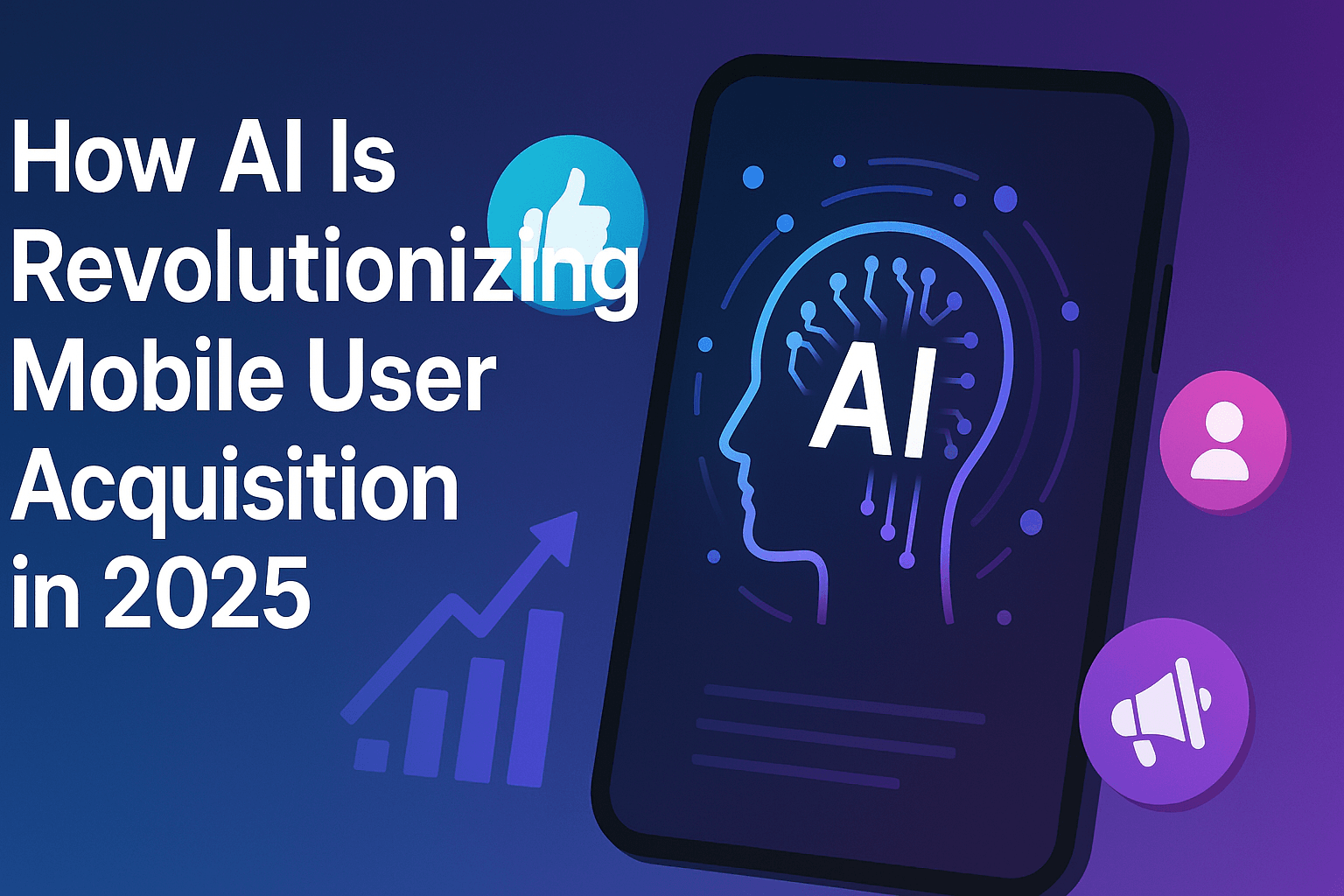How AI Is Revolutionizing Mobile User Acquisition in 2025
In 2025, Artificial Intelligence (AI) is no longer just a futuristic concept—it’s reshaping how mobile marketers approach user acquisition (UA). From automating creative production to optimizing bidding strategies, AI is empowering brands to dramatically reduce cost-per-install (CPI), increase return on ad spend (ROAS), and streamline overall UA management. According to All About AI, companies incorporating AI into their marketing strategies are seeing a 22% average increase in ROI, a 47% uplift in click-through rates, and campaigns launching 75% faster than those relying on traditional methods. Yet, with great promise comes the necessity for smart implementation, data-driven decisions, and an eye on evolving industry standards.

Let’s dive into how AI is transforming mobile UA, explore the tools shaping our industry, and highlight best practices for integrating advanced AI capabilities into your campaigns.
The Role of AI in Mobile User Acquisition
AI in mobile UA relies on machine learning (ML) and predictive analytics to automate campaign management, creative optimization, and strategic decision-making. Gone are the days of depending solely on gut instinct—today, AI provides actionable, real-time insights that drive more efficient user targeting and creative execution.Notably, Zipdo highlights that AI-driven algorithms now account for over 40% of global programmatic ad spending, demonstrating just how crucial AI has become for automating and optimizing user acquisition campaigns at scale.
How AI Enhances UA Campaigns
- Automated Bidding and Targeting: AI tools analyze historical and real-time user data, identifying high-converting audiences and adjusting bids accordingly. This dynamic optimization ensures you reach the right users, at the right cost, every time.
- Creative Production at Scale: Motion creative tools and smart platforms—like TikTok’s Smart Creative and automated design solutions—streamline the production of ad creatives. Platforms such as Segwise's creative tagging & analytics automate asset tagging, accelerate creative iterations, and supply insights to boost campaign efficiency.
- Creative Optimization: By aggregating performance data across ad networks, AI systems like Segwise recommend high-impact creative variations and enable fast A/B testing—effectively speeding up the creative development process and removing bottlenecks, especially invaluable for brands managing multi-market or large-scale initiatives. Zipdo further notes that AI-driven dynamic creative optimization can improve campaign performance by 33%.
- Smart Budget Allocation: AI-informed budget allocation leverages predictive analytics to forecast campaign success, ensuring that resources target the highest-ROI opportunities based on data, not guesswork.
By automating these workflows, AI allows marketers to focus on strategy while campaigns remain data-driven and adaptive.
How AI Tools Can Reduce CPIs and Increase ROAS
The principal goal for any UA campaign is maximizing ROAS while minimizing CPI. Here’s how AI delivers on both counts:
Reducing CPIs with AI
AI-driven automation optimizes every step of UA:
- Machine learning evaluates creative and audience performance to pinpoint combinations with the lowest CPIs.
- Automated bidding focuses budget on high-quality installs, minimizing wasted spend.
- AI-powered creative analytics, like Segwise’s, reveal which design elements drive engagement and lower acquisition costs by eliminating underperforming variants.
As highlighted by WiFiTalents, 78% of brands now use AI to optimize ad creative elements—an approach that’s proven essential in lowering acquisition costs and achieving campaign goals.
Increasing ROAS with AI Insights
AI platforms not only cut costs—they maximize impact:
- Predictive analytics identify which creatives and segments are primed for high returns, reallocating spend in real time.
- Creative tagging powered by AI uncovers content trends; next-gen features surface actionable insights, ensuring you deploy creatives most likely to boost ROAS.
- AI monitoring tools can detect sudden drops or anomalies in performance metrics, sending alerts before minor issues affect results.
A recent report from Octoboard also underscores how automation tools now provide advanced analytics for continuous strategy refinement, with predictive analytics allowing marketers to make data-informed decisions that significantly enhance campaign effectiveness and ROAS.Continuous, data-fueled optimization ensures each dollar spent delivers outsized impact for your UA efforts.
Key AI Tools for Mobile Marketing
A surge in smart platforms is transforming mobile UA strategy. Some top picks include:
Midjourney and Canva for AI-Generated Visuals
- Midjourney: Generate compelling ad visuals in seconds, using text prompts to create attention-grabbing imagery—no full creative team required. This is a game-changer for rapid creative experimentation.
- Canva’s AI Features: Automate repetitive design tasks, generate layouts, and get smart recommendations for fonts and colors. Canva’s AI Assistant personalizes design suggestions in line with campaign goals, empowering even non-designers to build high-impact ads at scale.
According to Marketing Dive, over 4 million advertisers are already leveraging generative AI tools for creative production, which speaks to the necessity of smart AI-assisted design in modern campaigns.
Copy.ai and Other AI Writing Tools
- Copy.ai: Remove creative bottlenecks by generating conversion-focused ad copy rooted in past campaign success. Its language models tailor tone and message to your targeted audience segments.
- Additional Solutions: AI-based copywriting tools enhance creative production by enabling large-scale variation and consistent messaging across A/B test groups—helping you find the formula that resonates best.
Other Notable AI Tools
Beyond Midjourney and Canva:
- Platforms with built-in creative monitoring and automated reporting tools help analyze asset performance, benchmark results, and inform creative strategy.
- Modern DAM (Digital Asset Management) systems, integrated with AI, auto-tag assets, categorize, and streamline workflow for marketers pushing high volumes of creative content.
Benefits of AI-Powered Video Production and UGC Generation
Video and user-generated content (UGC) have never been more essential in mobile marketing—and AI is supercharging both:
AI-Driven Video Production
- Intelligent automation handles editing, cuts, and effect suggestions.
- AI tools generate storyboard drafts, refine messaging to match brand voice, and optimize assets for channel-specific requirements.
- Instant feedback loops help marketers swiftly iterate—reducing production cycles and boosting campaign adaptability.
User-Generated Content (UGC) with AI
- Smart curation systems sift through social content, auto-selecting, tagging, and enhancing UGC that aligns with campaign goals.
- AI enhances UGC with subtitles, translations, or creative overlays to make global distribution seamless—and more accessible to diverse audiences.
Impact on Engagement and Conversion
- AI-driven creative analytics identify which content drives real engagement, enabling data-backed optimization for future campaigns.
- Personalization at scale ensures users see the most relevant, appealing content—amplifying conversions and long-term retention.
The Future of AI in Mobile User Acquisition
AI’s role in UA is only growing. Looking ahead:
Emerging Trends in AI-Driven UA
- Hyper-Personalization: Deep learning models will segment users with unheard-of precision, delivering uniquely relevant ad experiences to every potential customer.
- Voice & Image Recognition: AI-powered recognition technologies will unlock new ways to engage, measuring responses to sound, image, and even motion within creative assets.
- Creative Tagging and Monitoring: As creative volumes grow, automated tagging and analysis—like that from Segwise—will be critical to keeping campaigns optimized and measuring what matters.
- Advanced Predictive Analytics: Pattern recognition will drive smarter budget reallocation and campaign focus, surfacing opportunities and risks instantaneously.
Investment in AI-driven strategies is increasing industry-wide, with Search Engine Land noting that Google search ad spend rose 10% year-over-year despite evolving AI marketing trends—a testament to the effectiveness and continued growth of AI-powered UA.
How to Stay Ahead

- Continuous Learning: Foster AI literacy within your team to ensure you tap the full power of evolving AI capabilities.
- Ethical Oversight: Stay mindful of data privacy, bias, and regulatory changes as you scale automation.
Implementation and Challenges
Deploying AI effectively requires more than just new tools:
- Audit Existing Workflow: Identify bottlenecks and opportunities for automation.
- Select Purpose-Built AI Tools: Ensure platforms fit your needs—for creative analytics, monitoring, or asset management.
- Build Clean, Diverse Data Foundations: AI thrives on high-quality, well-tagged data. Maintain robust data hygiene and security policies.
- Balance Automation and Human Creativity: Leverage AI for efficiency, but keep human insight at the heart of strategy and review.
- Address Bias and Ethics: Regularly review AI outputs to mitigate risk and ensure fair, diverse campaign outcomes.
With these steps, you’ll integrate AI seamlessly—driving real results while upholding best practices.
Conclusion
In 2025, AI is transforming how mobile brands approach user acquisition. By automating creative workflows, unlocking actionable insights, and turbocharging campaign performance, AI enables marketers to reduce CPIs, maximize ROAS, and operate at greater speed and scale. Platforms like segwise.ai are setting new standards for creative tagging, analytics, and smart monitoring—empowering you to lead in an increasingly data-driven landscape.By embracing these advancements, investing in AI literacy, and keeping ethical considerations front and center, your team can shape the next era of mobile marketing—starting now.
FAQ: AI in Creative Analytics and User Acquisition
What are AI-powered creative analytics platforms?
AI-powered creative analytics platforms, like segwise.ai, use machine learning to evaluate and tag creative assets, providing deep insights into which visuals, copy, and elements drive campaign performance. These platforms can process high volumes of data, compare your results against industry benchmarks, and suggest actionable improvements for future creatives.
How do automated creative insights tools work?
Automated creative insights solutions leverage AI to analyze campaign data, quickly surfacing trends, identifying best-performing content, and highlighting patterns in user engagement. Segwise.ai’s creative tagging and analytics is a leading example, providing both real-time feedback and strategic reporting so marketers know exactly what’s working—and what isn’t.
What is AI creative tagging and classification, and why is it important?
AI creative tagging and classification involves automatically labeling creative assets with relevant tags (such as theme, format, or emotional tone) using advanced recognition models. This process is crucial for large brands managing diverse content libraries, as it streamlines asset organization, speeds up A/B testing, and ensures the right creative is delivered to the right audience at scale.
How can AI help detect creative patterns and optimize ad performance?
By leveraging machine learning algorithms, platforms like segwise.ai can spot hidden correlations in your creative assets and campaign outcomes, suggesting optimizations that might be missed by manual analysis. This leads to smarter creative development and more effective, data-driven campaigns.
Are there risks or challenges with using AI for creative analytics?
Yes. The quality of AI outputs depends heavily on having robust, diverse data. Poorly labeled or biased data can introduce inaccuracies. Brands like segwise.ai recommend strong data governance, ongoing human oversight, and a focus on privacy and ethical standards as you implement AI in your creative workflow.

Comments
Your comment has been submitted successfully!